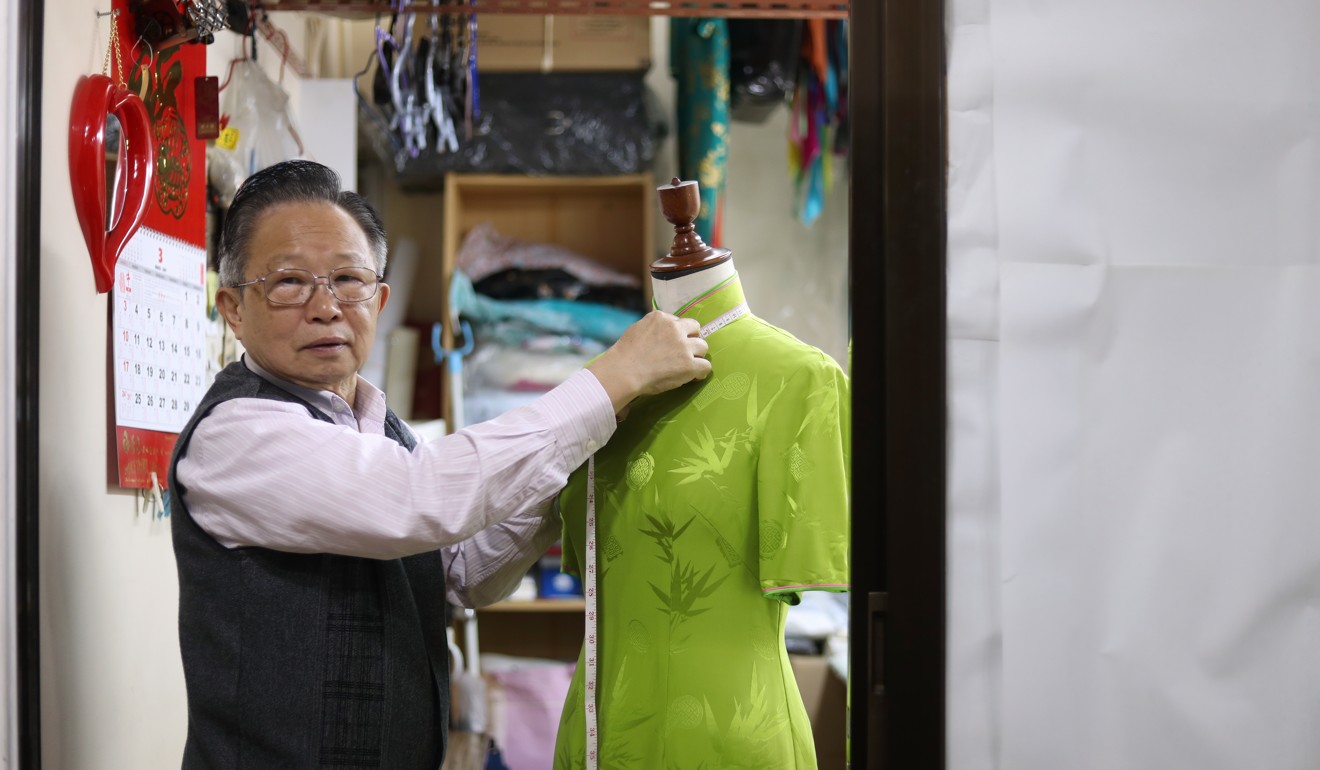
Master of a dying art: traditional dressmaker recalls golden era of cheongsam in Hong Kong
- From the hustle and bustle of Causeway Bay in the 1950s to learning new skills in Japan, Fung Yau-choi has seen it all
Sitting in a humble studio in the corner of a shopping centre in Kowloon City, tailor Fung Yau-choi recalls the hustle and bustle of cheongsam stores in the 1950s.
“Back then, cheongsam was for everyone, from distinguished ladies and madams to backing dancers at nightclubs,” he says, referring to a traditional Chinese dress style known for its feminine body-hugging features.
“There were at least 20 tailor’s shops in Causeway Bay alone, and in the busy days, a master needed to make up to three dresses or gowns per day.”
With a one-way train ticket and the help of an uncle, Fung, a Shanghai native, immigrated to Hong Kong at the age of 12, and joined his brother and others in learning the art of dressmaking.

The 74-year-old master says he is one of the four or five tailors living in the city with skills from that generation.
Handmade and delicate, Shanghai-style cheongsam was once widely celebrated in Hong Kong, because it differed from dresses produced on sewing machines, a method that derives from Guangdong, according to Fung.
“It was a prosperous business, but as a kid I was just excited about being in a big city,” says Fung, whose father also worked in the industry. “My relative sent me to a tailor’s as an apprentice, and the shop owner basically raised me as his son.”
He used to run from Causeway Bay to Central every day to pick up fabric, and very often the tailors were too busy to supervise him, so Fung would just help out and watch them working until the small hours.
Five dressmakers keeping the cheongsam alive in Hong Kong
“I didn’t choose to become a tailor; parents decided everything for children at that time. But I did try hard to figure out my life, and left things at home [in Shanghai] in the back of my mind,” he says.
The second child in the family, Fung rarely wrote letters to his parents after moving to Hong Kong. At 14, Fung was told his mother had passed away, but it took him another 10 years to return to Shanghai.
“I just thought: your home is Hong Kong now, and you can’t look back,” he says.
After six years of apprenticeship, Fung was finally qualified and employed as a tailor in 1963, only to find the glorious days just about to fade. Ever since modern apparel stores started to prevail in the 1970s, many cheongsam makers have decided to seek other job opportunities in places such as textile mills and dyeing factories.
“Traditionally, dressmakers like us get paid on a piecework basis, and it was hard when the demands began to decline,” Fung says.
Determined to feed his family as a tailor, Fung, a married man by then, accepted a job in Japan in 1978. The established tailor found himself adapting to a quite different work style and environment.
For one thing, he had to use materials from Europe, and change the style of his work according to the Japanese owner’s design.
“I was the only tailor who makes Chinese costume, whereas others work on modern clothes. So once again I learned through observation, just like when I was a newbie apprentice.”
His daughter, Natalie Fung, remembers the only time she visited Fung in Japan as a high school student. The father who “seldom says sweet words” showed her the holiday postcards he received from the family, all carefully kept in a box.
“All those years alone in another country, He must be lonely and stressed,” the 34-year-old says, adding that she only saw Fung twice a year before he finally returned to Hong Kong in 2008.
More than a dress - the social history of the cheongsam in Singapore
Fung says that it takes “patience, attention to detail and willingness to absorb new skills” to build a reputation as a cheongsam master, adding that a sense of aesthetic comes from skill and experience.
For Fung, it is hardly possible for people now, with limited time and energy, to be immersed in this kind of practice.
“[Cheongsam making] is doomed to become a lost art, and there’s nothing to do about it. I am certainly not the best tailor in this profession,” the master says.
Still, he was able to make his daughter two wedding dresses within two days, which he boasts as “taking much more efforts” than ordinary ones.
“We went to pick the fabric together, one in pink and one in red,” Natalie says. “It was a really touching experience.”
The father, somehow bashful, joked about it with a laugh: “It’s not a big deal. She probably thinks it’s normal for dad to do so.”

